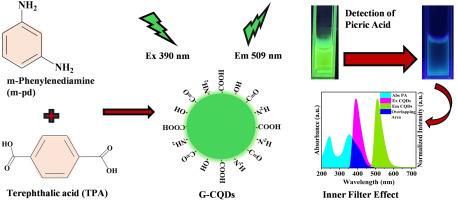Mechanistic elucidation of novel carbon quantum dots with high selectivity and sensitivity for picric acid detection
IF 6.3
3区 工程技术
Q1 ENGINEERING, CHEMICAL
Journal of the Taiwan Institute of Chemical Engineers
Pub Date : 2025-09-28
DOI:10.1016/j.jtice.2025.106432
引用次数: 0
Abstract
Background
Carbon quantum dots (CQDs) have evolved as promising alternatives to traditional semiconductor quantum dots due to their high photoluminescence, stability, tunable emission wavelengths, and diverse applications.
Methods
In this study, a novel precursor system composed of terephthalic acid and m-phenylenediamine was developed to synthesize CQDs. The as-prepared CQDs were characterized and applied for picric acid (PA) detection in various environmental samples. Moreover, the underlying sensing mechanism was thoroughly elucidated.
Significant findings
The CQDs exhibited excitation-independent green emission at 509 nm with a high quantum yield of 56.3 %. Characterizations confirmed that the green-emissive CQDs (G-CQDs) possessed a graphitic carbon framework and abundant surface functional groups, which contributed to excellent colloidal stability and robust photoluminescence across a wide range of pH values, ionic strengths, storage durations, and under prolonged UV irradiation. For PA sensing, the G-CQDs demonstrated high selectivity and sensitivity, achieving a low detection limit of 17 nM. This sensing capability was not affected by the presence of various cations and anions, and was successfully validated in real samples including sea, river, and tap waters. Mechanistic investigations revealed that the sensing process was primarily governed by the Inner Filter Effect (IFE), rather than by dynamic or static quenching pathways.

具有高选择性和高灵敏度的新型碳量子点检测苦味酸的机理研究
碳量子点(CQDs)由于其高光致发光、稳定性、可调谐的发射波长和多种应用而成为传统半导体量子点的有前途的替代品。方法以对苯二甲酸和间苯二胺为前驱体制备CQDs。对所制备的CQDs进行了表征,并应用于各种环境样品中苦味酸的检测。此外,还深入阐明了其潜在的传感机制。CQDs在509 nm处表现出与激发无关的绿色发光,量子产率高达56.3%。表征证实了绿色发光CQDs (G-CQDs)具有石墨碳骨架和丰富的表面官能团,这有助于在广泛的pH值、离子强度、储存时间和长时间紫外线照射下具有优异的胶体稳定性和强大的光致发光。对于PA传感,G-CQDs具有较高的选择性和灵敏度,达到了17 nM的低检测限。这种传感能力不受各种阳离子和阴离子存在的影响,并在实际样品(包括海洋,河流和自来水)中成功验证。机理研究表明,感应过程主要由内滤效应(IFE)控制,而不是由动态或静态猝灭途径控制。
本文章由计算机程序翻译,如有差异,请以英文原文为准。
求助全文
约1分钟内获得全文
求助全文
来源期刊
CiteScore
9.10
自引率
14.00%
发文量
362
审稿时长
35 days
期刊介绍:
Journal of the Taiwan Institute of Chemical Engineers (formerly known as Journal of the Chinese Institute of Chemical Engineers) publishes original works, from fundamental principles to practical applications, in the broad field of chemical engineering with special focus on three aspects: Chemical and Biomolecular Science and Technology, Energy and Environmental Science and Technology, and Materials Science and Technology. Authors should choose for their manuscript an appropriate aspect section and a few related classifications when submitting to the journal online.

 求助内容:
求助内容: 应助结果提醒方式:
应助结果提醒方式:


